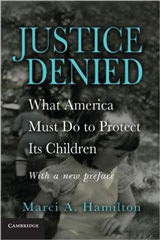There is a pandemic of child sex abuse across the globe. From religious institutions to universities to boarding schools and, of course, families, we now know that 1 in 4 girls and 1 in 6 boys are sexually abused by age 18. That knowledge is spurring a legal reformation for the protection of children, and insurance carriers should be a part of this noble movement.
Many were shocked to learn that Catholic dioceses and orders have been carrying insurance coverage for the negligent prevention of child sex abuse. But that became clear when the victims straggled and then ran into the public square in 2002 when the Boston Globe’s Spotlight series unveiled the wretched cover up. In states where victims could sue, because the statute of limitations was lifted, justice ensued. Insurance companies have been major contributors to settlements, because youth-serving organizations had paid premiums for decades for negligent failure to prevent child sex abuse. Indeed, the most significant litigation in the Penn State Jerry Sandusky scandal involved two insurance companies.
To date, the insurance industry has taken the shortsighted view of the child sex abuse cases, ramping up furious lobbying against the victims’ access to justice in state after state. They routinely lobby quietly but effectively against the victims. The result is that in states like Pennsylvania and scores of others, victims cannot safely name their perpetrators and the cost of abuse rests on the suffering victims and the state. The insurance lobby keeps the institutions and families safe from public disclosure, thereby creating a yellow brick road for child perpetrators. That is the opposite of risk-reduction, is it not?
Some insurers also reacted to the scandals by removing negligent child sex abuse from coverage. This is pretty galling when you consider that they were content to reap premiums when victims were silent but cut off the coverage once the child sex abuse movement and then the #MeToo movement empowered victims to name their perpetrators and enabling institutions. Instead of retreating from the field, they can become warriors for the children and, at the same time, reduce their risk under such coverage.
We wear seatbelts and babies are in appropriate car seats because of the insurance industry, as I discussed here. Now it’s time for this influential and powerful industry to move away from its policies that are hiding child predators and failing to deter institutions from bad practices. They can be a major player in preventing child sex abuse, thereby reducing society’s risk and their own.
Two straightforward reforms are needed to make the insurance industry a positive force instead of a barrier to child sex abuse prevention.
First, states should mandate that insurance carriers cover negligent failure to prevent child sex abuse in youth-serving organizations. This is the prod that is needed for all organizations affecting children to have the best policies. The institutional instinct is routinely to cover up this sort of wrongdoing from the outside world because it besmirches reputation and threatens income. We can counteract that instinct.
Second, states should require insurance carriers to conduct an annual state-of-the-art “child protection audit” each year. If the organization fails the audit, insurance carriers should deny coverage until the organization has cured it. Insurance companies already do financial audits and building safety audits as prerequisites to coverage. They are in the best possible position to be able to perform and enforce a child protection audit.
This insurance safety net for children is necessary because the criminal justice system simply does not deter or capture enough perpetrators when the victims are children. Prosecutors refuse to pursue cases where the evidence does not prove the crime “beyond a reasonable doubt.” When the victim is four years-old and the perpetrator is an adult that burden of proof can be extremely difficult, which means the vast majority of child sex assault falls through the cracks of the criminal justice system.
On average, according to the best science, child sex abuse victims disclose when they are age 52. That means a perpetrator who sexually assaults a 6-year-old has about 46 more years to abuse more children until the first victim is able to surmount the effects of the trauma, shame, and humiliation to come forward. With perpetrators abusing approximately 150 children over their lifetimes, that is a lot of sexual abuse that needs to be prevented through other means.
A state-of-the-art child sex abuse prevention program would mandatorily educate employees on the best rules around children. For example, there needs to be a principle where adults may not spend time with children alone in closed spaces. A vast amount of abuse occurs because it can in cars, closed rooms or offices, the confessional, and examination rooms. Employers need to require open-door policies, and a “2-deep” rule where there is always a second adult in the vicinity. Pediatricians need a nurse or parent in the room. Coaches may not drive children home alone. Tutors may not come to the child’s house alone. Administrators, employees, volunteers and parents need to be trained on the signs of child sex abuse both from the perspective of how pedophiles operate and how children act when they have been victimized.
There is a bright future for child protection if everyone plays a role. It’s time for the insurance carriers to become part of the solution to child sex abuse.









